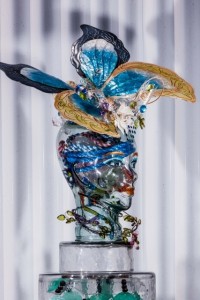![securedownload[3] (2)](https://flaneur.me.uk/wp-content/uploads/2012/07/securedownload3-2-480x381.jpg)

When King Eurystheus sent Heracles to kill the Lerraean Hydra, Heracles didn’t know at first what he had gotten into. Each time he cut off one of the seven heads of the snake, two started growing again in its place. The struggle ended when Heracles finally realized that he needed to smash the head of Hydra to stop more heads from growing.
Struggle is also a theme that permeates throughout the works of Santa Monica-based artist Fariba Ameri. However, unlike in Greek mythology, in Ameri’s mixed media works it’s not the struggle of a person with a serpent, but of women’s struggle with the pressures of staying beautiful and youthful, to be nurturing mothers, excellent cooks, devoted wives and loving caretakers, while being expected to give up their own dreams and desires for the sake of a happy family life. What makes Ameri’s work distinct and fascinating is the way she captures the complexity of women’s psyche. Always with solemn and reflective facial expressions, her female figures are portrayed against colorful and detailed backgrounds, sometimes in the form of collages that not only suggest their multicultural experience, but also the long history of the countries they derive from. Ameri, born into a multicultural family, has deep roots in Tehran. Her interests are in the history and mythology of Persian culture.
![securedownload[3] (2)](https://flaneur.me.uk/wp-content/uploads/2012/07/securedownload3-23-231x300.jpg)
Her oeuvre is reminiscent of the works of Wassily Kandinsky, Eduard Munch, and Vincent Van Gogh due to the sensibility for color, psychological depth, or self-expression. As much as Ameri’s works are personal, they’re also universal. “Witness” depicts what seems to be an Egyptian goddess lying on the ground with her eyes wide open and New York, with its various architectural styles, on top of her. Right away this piece evokes the idea of the immigrant experience, the clash between the old and new world. The narrative that unfolds through it could be about a Middle-Eastern female in America, who is aware of the cultural differences of her home and adopted country without having fully engaged in her new life yet. She sees New York filtered through her old values.
As the title implies, “Memoir in Blue” is about the passing of time. Influenced as it seems by Amedeo Modigliani, the female’s long oval-shaped face appears to be frozen while she’s holding a book in her hand with a smiling woman on the cover page. Similar to “Painter in Disguise”, in which Ameri added a used tube of color from her studio into her work to suggest a painter’s tools, she integrated a pair of scissors into “Memoir in Blue” to suggest a happy, but closed chapter in her life. The integration of real objects can be interpreted as a metaphor for one’s true self. “Subjective Truth” offers an image of a nude woman who is blindfolded. This work plays with the idea of perception and that the way we perceive the world is based on our past experiences.
![securedownload[4]](https://flaneur.me.uk/wp-content/uploads/2012/07/securedownload42-231x300.jpg)
In her series “Beauty in Disguise”, the viewer is offered a variety of mixed media works featuring luxurious articles, such as jewels, beads, and rich fabrics, from which underneath the head of a woman appears, with her face hidden behind a mask. Ameri’s idea behind this series is to juxtapose beauty as it has been described in Persian poetry; kings and their fortunes, acquired by worldly possessions, that they then lost, against the beauty that comes from within – hence one’s spirit and one’s true self, which is stable and permanent.
In addition to “Women of all Ages” and “Beauty in Disguise”, Ameri also created “Noor,” which was inspired by the celebration of No-Rooz, the Persian New Year, and the teachings of the prophet Zoraster. In contrast to the real Persian New Year that is celebrated on the first day of spring, “Noor” is timeless. The celebration of No-Rooz also includes Haft Seen, a traditional table setting that is comprised of seven symbolic items, each starting with the letter “S”, offered in small glass dishes, placed on top of a table. This also influenced Ameri; her Haft Seen includes seven stunning glass sculptures with English titles. Each sculpture is covered with various materials – moss, pearls, colorful glass ornaments, a bird’s nest, and flexuous wire – and filled with household items that are formed into attractive art objects. “Fish” is a symbol for life; “Equinox”, the celebration of seasons and the life force behind it. “Patience” is the virtue of contemplation and reflection; “Prosperity”, the celebration of one’s inner wealth, honoring one’s values. “Apple” stands for one’s health and the temptations of life; “Rebirth” for renewal and celebration of growth; and “Butterfly” for the delicateness of one’s health.
The glass that composes the sculptures serves two purposes. For one thing, it represents the nature of women, hence the sculpture’s strong and fragile sides. For another, they allow Ameri to toy around with the idea of dualism in Zoroastrianism and therefore the existence of good and evil. Thus, the light that enters through the glass and illuminates it from within can be understood as the positive force that is trying to win over the darkness.
As a whole, Ameri’s oeuvre appears like a lavish buffet with many savory and exotic dishes that are not only stimulating for one’s eyes and taste buds, but also for one’s soul.
– Simone Kussatz –
Copyright © Simone Kussatz
Images © Courtesy of Fariba Ameri

Leave a Reply